Game of the Year 2022
There was a period this year when I thought I might have hit a video game saturation point. Nothing was appealing to me; I kept bouncing off games right away and had trouble fully engaging with anything. (Part of this may have been the sheer availability of so many games through Xbox GamePass, which made it possible to give up on a game with minimal financial investment.) Dragon Quest XI, Guardians of the Galaxy, Pentiment, and Elden Ring (!) were among the games that I started and dropped, some of them multiple times. (After spending $70 on Horizon: Forbidden West, I saw it through to the end—though I probably would not have otherwise.)
The result is that 2022 has been a year in which I’ve gotten a better sense of my gaming tastes—and perhaps more importantly, felt okay not persisting with games outside those tastes if I’m not enjoying them. Long RPGs, dialogue-focused games, and extremely difficult games may simply not be for me. That’s not to say that I won’t ever try those sorts of titles again—I’m certainly looking forward to the next Like a Dragon game, a role-playing game with tons of dialogue. But I won’t force myself to play them if I’m not into them.
Ultimately, I think my preferences this year came down to a distinction I first heard articulated on the Fire Escape podcast—“talk-y”games vs. “do-y”games. In a “do-y”game, you are in almost constant control, moving the game forward through action and active choices. In a “talk-y”game, the action is broken up by cutscenes that move the story forward, and sometimes the gameplay also consists partially (or entirely) of dialogue choices rather than movement, exploration, and combat. I found myself leaning toward “do-y”games this year more than in the past.
Another thing that happened, especially at times when I found myself uninterested in current releases, is that I spent a lot of time playing games from previous years. That included relatively recent stuff (Spider-Man: Miles Morales, 2020), games from the previous generation (Halo Wars 2, 2017), things from long ago (WinBack, 1999), and releases from the distant past (Gradius, 1986). Almost all of this was fueled by the availability of catalog games on modern consoles through Xbox Game Pass, the new PlayStation Plus tiers, and Nintendo Switch Online. Thanks, corporations!
I also spent a decent chunk of time this year playing games outside the normal PC/console world. The Playdate, a charmingly retro handheld, is a brilliant idea that I haven’t played much since the few weeks after I got it, but that I’m glad I have one. And I played a heck of a lot of web-based word games, including Wordle (and Quordle) and the New York Times’s Spelling Bee. So I guess I did do a lot of gaming this year, even if it wasn’t always focused on new releases. Still—I found a lot to like in the handful of 2022 releases that stuck with me. Here are the best five.
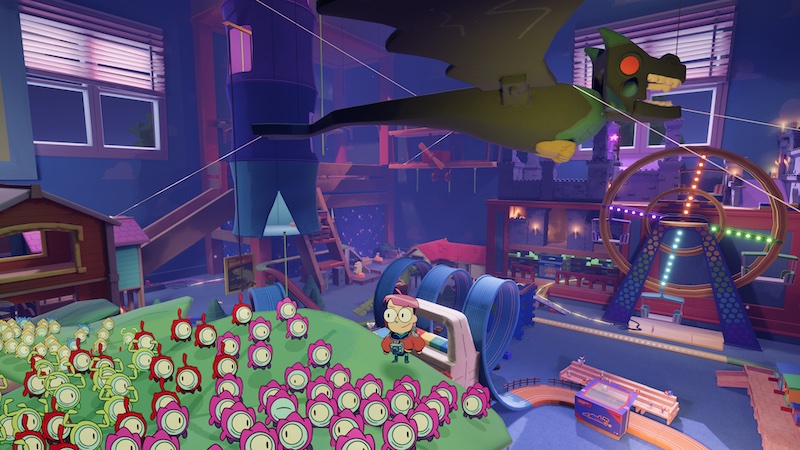
5. Tinykin
Developed by Splashteam. Released August 30. Played on Xbox Series X.
Ever since the GameCube days, I’ve been a big Pikmin guy. In that Nintendo franchise, you play as a little astronaut who crash-lands on an alien world. You find local creatures that look like little sprouting seeds with arms, legs, and eyes; these are Pikmin. You can gather dozens of Pikmin, then command them to do things, such as build a bridge, or carry a large object, or fight an enemy; the series was a cool, light real-time strategy game, a pretty unique thing on a console. It was also a great entry in the “little guy in a big world”genre of games; the astronaut and the Pikmin were tiny, with plants and small everyday objects towering over them. You might, for instance, need 20 Pikmin to pick up a D-cell battery. The one thing I never loved about the Pikmin games was the time pressure. There was always a ticking clock, and you had to get back to your spaceship in a certain amount of time. This was a drag on an otherwise fun series—the environments were beautiful, and it would have been nice to have more freedom to explore them.
Along, this year, comes Tinykin, from the French developer Splashteam. It’s an obvious riff on the Pikmin formula. You’re an astronaut, you arrive on an alien world, and you find little creatures (Tinykin). It’s a “little guy in a big world” game—the whole adventure is set inside a normal Earth house, and you’re about an inch tall, so you’re scaling appliances, climbing stacks of books, moving through air ducts, etc. But Tinykin makes some smart choices that differentiate it from Pikmin, and indeed make it more fun in some ways than the series that inspired it.
First, there’s no time pressure whatsoever. You can spend as much time as you want exploring the environment. This is great, because the rooms of the house are enormously fun to explore; the use of real-world objects at massive scale is endlessly clever and inventive, and seeing what lay around the next corner helped propel me through the game. What’s more, the game design is perfectly suited to encourage exploration. Tinykin is essentially a collect-a-thon, the sort of game in which the environment is packed with items to collect and check off a list; tons of these items are out in the open, but a lot are hidden by environmental puzzles that range from simple to moderately complex.
Second, there’s no combat. In Pikmin you’d routinely send squads of Pikmin to their doom against a huge bugs or birds, and seeing them die (and their little souls literally fly away) was always kind of a bummer. In Tinykin there’s no combat whatsoever—the game is purely about exploration, and there are no active threats against the player character. In some places you can accidentally fall from a great height and die, but the game instantly respawns you close by, so there’s effectively zero penalty for experimentation. The result is that Tinykin was one of the most chill gaming experiences of the year for me. The game is difficult enough to require you to plan out your next exploratory move, but never so challenging that you get stuck or frustrated. It’s satisfying to pick up hundreds of little collectibles per level, and delightful to be taken on a tour of each environment as you’re seeking those collectibles.
The one knock: at first I was put off by the game’s visual design, to the point where I almost set it down after the first hour or so. The environments have a cartoony three-dimensional look that works fine, but all the characters are flat, like a two-dimensional cartoon. That is, if you rotate the camera around your player character, the same flat face of him is always facing the camera. For whatever reason I disliked this at first, but once I got over it, I enjoyed Tinykin a great deal.

4. Vampire Survivors
Developed by Poncle. Released October 20. Played on macOS.
Vampire Survivors is a top-down pixel-art game in which you must defeat hordes of enemies coming toward you. As the player, you can move up, down, left, and right. That’s basically all the interaction you get. You don’t actively aim or fire; any weapons you acquire fire off automatically. For example, the Knife shoots forward in the direction you’re facing. The Fire Wand launches a fireball at a random enemy. The King Bible circles around you and damages enemies that it touches. (You know, the things that a Bible does.) As you defeat enemies, you gain experience points toward leveling up; each time you level up, you can select a new weapon (you can have up to 6 at once), power up a weapon you already have, or choose a non-weapon power-up (e.g., increase your defense).
Each run starts calmly, with a single weapon that fires slowly and isn’t especially powerful, and a couple of enemies moving toward you. Over the course of the next thirty minutes, things steadily ramp up as you acquire and enhance weapons; the quantity and power of enemies increases to match. By the end of a run the game devolves into pure chaos, with hundreds of projectiles and explosions bursting outward from the player character, destroying dozens of enemies at a stroke, clearing the way for hundreds more to descend upon you. It gets chaotic.
The genius of Vampire Survivors is the perfectly tuned amount of mental focus it requires. In the midst of the action you’re only moving your character around. But as you level up, you do need to think a bit to select which of three random weapons/power-ups you’d like to choose. (The game pauses while you’re selecting one, giving you a moment to breathe and strategize.) If you make the right selections, you can end up with a character so powerful that the game basically plays itself—you’ll constantly be emitting so many fireballs/knives/Bibles/etc. that even if you just stand still, no enemies can come close to touching you. It’s extremely satisfying to absolutely melt these enormous hordes of foes, and at the same time you can divide your attention with a podcast or TV show or something else. Vamp Surv (as it’s known in my household) is definitely the Podcast Game of the Year—playing a few runs has been a great way to clear out a podcast backlog.
Also, and not to make this about a “gaming hours per dollar” kind of thing, which isn’ t a great metric, but—Vampire Survivors was $3! For me it was unquestionably the best value in gaming this year.
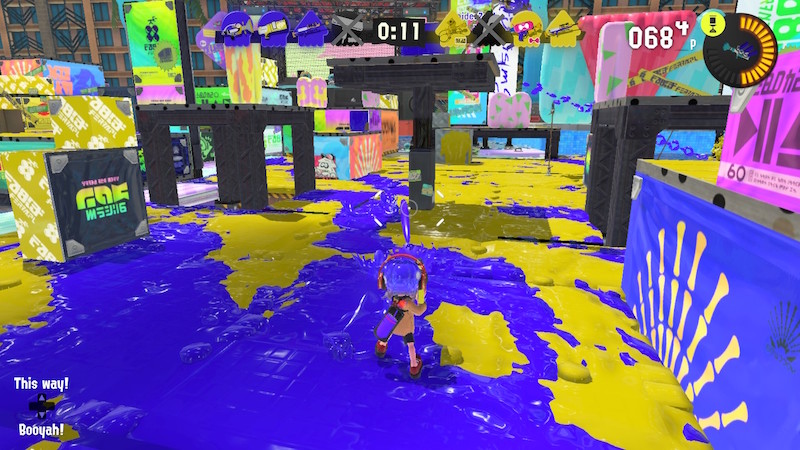
3. Splatoon 3
Developed by Nintendo. Released September 8. Played on Nintendo Switch.
Like the Jelly-of-the-Month club, Splatoon 3 is the gift that keeps on giving.
For the unfamiliar, Splatoon 3 is the third entry in a Nintendo-developed series of competitive four-on-four online shooters. You play as half-kid, half-squid creatures called Inklings, and you’re shooting ink, not bullets. Each team shoots a different color of ink. The goal is for your team to cover a higher percentage of the ground its ink by the end of the three-minute round. Some of the weapons are gun-like (paintball guns, squirt guns, etc.), but others include just about any other kind of implement that one might use to disgorge ink. Players use paint rollers, brushes, and even little washing machines to cover the stage in ink. If you want, you can shoot the other team’s players—this can be useful because it forces them to respawn at their base, robbing them of valuable inking time—but the main objective is to spray/roll/brush/toss as much ink as possible. This was a brilliant Nintendo twist on the online shooter formula in the first Splatoon back in 2014, and it still works great today.
What I’ve described above is the Turf War mode, the main competitive aspect of Splatoon 3. If that were the only thing included in the package, I’d be decently satisfied—as in the previous entries, it remains a ton of fun. But then I tried out a new feature in Splatoon 3, Tableturf Battles. This is essentially a Splatoon-themed board game within a game with simple rules, surprisingly deep strategy, computer-controlled opponents, and even a card-collecting element. After playing many hours of Turf War, I tried out Tableturf and quickly got hooked, pouring lots of hours into this side mode.
I felt even better about my purchase at this point. But then, after exhausting most of the Tableturf content, I turned to another major pillar of the Splatoon 3 package—the single-player campaign. There’s an extensive series of single-player levels that cleverly use the core Splatoon mechanics for combat, puzzle-solving, platforming, and more. The mode also has a satisfying loop of collecting resources, then using them to unlock new parts of the overworld map. Smartly, the single-player challenges force you to try new weapons and abilities in a way that makes you think creatively and try stuff you might not have in the normal Turf War mode.
By the time I’d finished the single-player campaign, Splatoon 3 had locked in a place on my game-of-the year list. But guess what? There’s yet another mode that I’ve barely touched yet. Salmon Run is Splatoon 3’s cooperative online mode, where you team up with other players to defeat waves of computer-controlled enemies. I was never a big fan of Salmon Run in Splatoon 2, where it debuted, and I’ve tried just one or two rounds in the new game. I’m unlikely to go back to it, but it says a lot that I can ignore this entire chunk of the game while still feeling like I’ve got my sixty bucks’worth out of Splatoon 3.
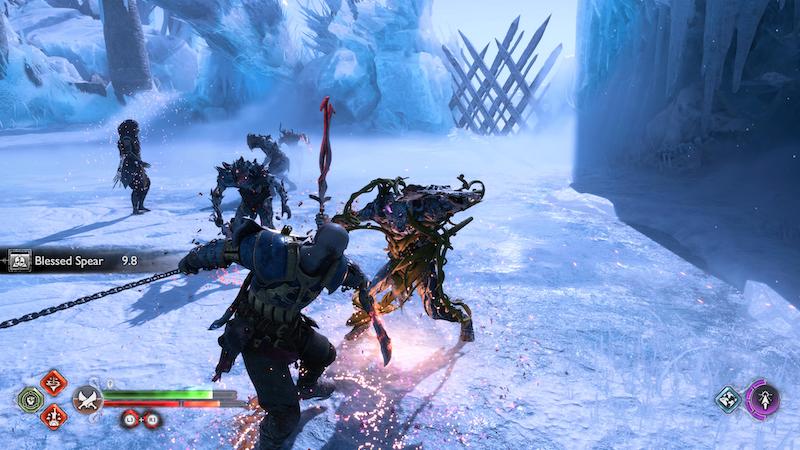
2. God of War Ragnarök
Developed by Santa Monica Studio. Released November 8. Played on PlayStation 5.
God of War Ragnarök is an outlier on this list. For one thing, it has a budget that is almost certainly at least ten times the budgets of all the other games on this list combined, and perhaps more than that. It’s the only game on the list that has significant human performances in it. It’s also the game that the most frequently reminds you that it’s a video game. But let me back up.
God of War Ragnarök is the sequel to 2018’s God of War, which was a reboot of the long-running God of War series of games. The franchise began on the PlayStation 2 in 2005, and for many years it was characterized by violence, revenge, and an adolescent sensibility (e.g., PG-13–level sex minigames.) Its central character, Kratos, is a Spartan warrior who is tricked by Ares into killing his own family, and subsequently seeks revenge against assorted members of the Greek pantheon. The 2018 God of War game changes the tone significantly. Kratos is older, has moved to Scandinavia, is caring for a new son, and has left the god-killing business. The juvenile tone is gone, replaced by heartfelt father-son bonding, reflections on Kratos’past actions, and believable character growth. (The violence is still there, though.)
That game was great, and the follow-up picks up where it left off. Ragnarök is one of Sony’s big-budget tentpole releases, and the money is absolutely on the screen. This is one of the best-looking games you can play right now on a PlayStation 5;it’s one of the rare games where it’s satisfying just to stop a minute and take a closer look at a building, or the plants in a humid swamp, or a trippy Norse-mythology vista.
Richard Schiff plays Odin. That’s right, Toby from The West Wing is taking on his first video game role as the All-Father, and he naturally does a phenomenal job. The combination of motion capture and voice acting throughout the game is top-tier, and Schiff is the MVP. His Odin is like a mob boss who always comes off as outwardly friendly and reasonable but who clearly has darker motivations;I couldn’t look away whenever he was onscreen. The rest of the cast is super strong too, particularly Christopher Judge as Kratos;the tough-and-gruff nature of the character limits the range a bit, but Judge does a great job fleshing out a character that, at the franchise’s beginning, was a generic raging warrior.
Okay, the thing I said above about how God of War Ragnarök frequently reminds you it’s a video game? It’s both good and bad. In one sense, this comes through in the character dialogue and interactions. One example: there’s a section where you (Kratos) are moving through Alfenheim, the realm of the elves, alongside your son (Atreus) and the god Tyr. As someone playing a video game, you’re naturally checking side paths and areas for extra treasure and secrets, rather than beelining straight to the story objective. When you do this, Tyr sort of calls you out for not attending to what, for him, a character in the game, is the important story. Atreus responds to Tyr, simply explaining “My dad likes loot.”This is cute, and I liked these elements.
However, the game also reminds you it’s a video game with the overwhelming number of options for equipment, skills, and upgrades, which are chosen via a byzantine set of menus. These options feel so granular as to seem meaningless at times;it can become unclear exactly how choosing one piece of armor over another will actually affect gameplay. Seeing all the numbers and statistics tended to really drive home the underlying construct of the game in a way I didn’t enjoy. Fortunately, it was no problem for me to pick a few preferred equipment options early on, stick with them, and largely ignore the overly complex systems.
That nitpick aside, God of War Ragnarök is a fantastic game. The presentation is supremely polished, but the story is also compelling, as is the core combat gameplay loop. All of these aspects kept me hooked for the thirty-plus hours it took to complete the game.
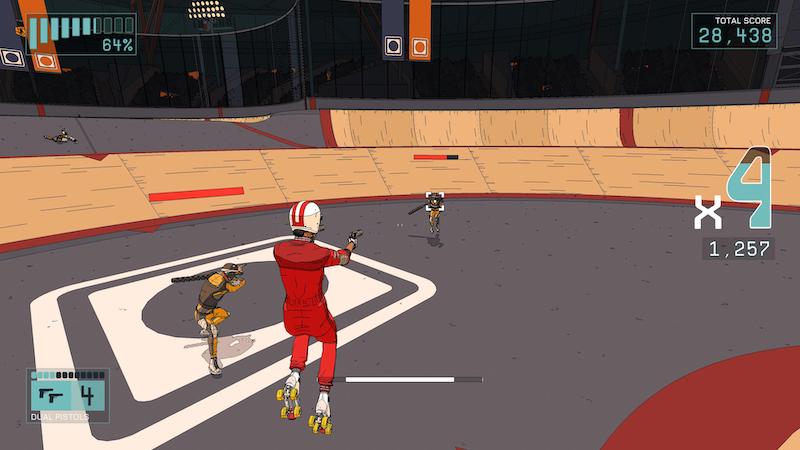
1. Rollerdrome
Developed by Roll7. Released August 16. Played on PlayStation 5.
Everything comes together brilliantly in Rollerdrome. The game is set in a dystopian near future where a new bloodsport has become a popular form of entertainment. Contestants equipped with guns roller skate through arenas filled with ramps, rails, and assorted enemies. They must survive to win.
The first thing you notice is the striking aesthetic, a cel-shaded look with clean lines and muted colors (outside of the bright-red jumpsuit of the protagonist, Kara Hassan.) The style is simple but perfect for the 1970s-tinged dystopia the game is going for. The aesthetic excellence extends to the music, a droning synth score that meshes great with the visuals.
So Rollerdrome looks and sounds great, but how does it play? Also great! The standard comparison is “Tony Hawk’s Pro Skater with guns,”or more specifically “Tony Hawk’s Pro Skater meets Max Payne,”given the slow-mo shooting, and those are accurate. But this description undersells how well those elements converge without feeling derivative of their inspirations. For me, and I suspect for many Tony Hawk fans, the controls of that series are so ingrained that playing any skating game without them simply feels wrong. It’s a testament to how well Rollerdrome works that I didn’t get that sense at all;I was able to quickly acclimate to its unique style of skating.
Getting the controls right is of course important, but all the game design that flows from that still has to work well, and this is where Rollerdrome really shines. In the game you have four weapons to choose from: dual pistols, a shotgun, a grenade launcher, and a laser gun. They work differently enough to feel distinct, and have clearly defined uses against the various enemy types. One of my favorite parts of the game was learning the internal calculations of the game design and using that to my advantage—gun A has B shots in its magazine, and enemy C takes B shots to take down, and he puts up a shield if you don’t fire all the shots in D seconds. So if you can empty the magazine into him, you can take him down in one go without having to circle back for another pass. You discover predictable patterns like this that can be used to assemble a perfect run as you learn each level’s layout and enemy placement.
Brilliantly, all the guns share a single pool of ammunition, giving the player a bit less information to juggle in the heat of a match. Even more brilliantly—the way you reload that ammunition is by doing cool grabs, flips, and grinds. Awesome! It’s such a smart way to mix combat with trick-based gameplay in a way that feels satisfying and looks radical.
Rollerdrome was a challenging game at first, but in a way I enjoy. When I got killed, I had a clear sense of what I could have done better. And since the rounds last only a few minutes, I could quickly apply those lessons and try a new tactic the next time. Over the course of the game, I could feel myself improving. After finishing the campaign, it was actually thrilling to go back to the early levels—which I had struggled with originally—and find that I could absolutely destroy them with my hard-earned skills. It felt like climbing a mountain and looking down on the gorgeous vista below, only with more roller skates and shotguns.
Other Notable Stuff I Played This Year
Wordle
I played Wordle just about every day this year, and it’s still good! Doing Wordle in the morning and sharing my results on my workplace Slack has been a fun little community ritual, especially when so many people are working remotely. Still looking for a first-guess bullseye!
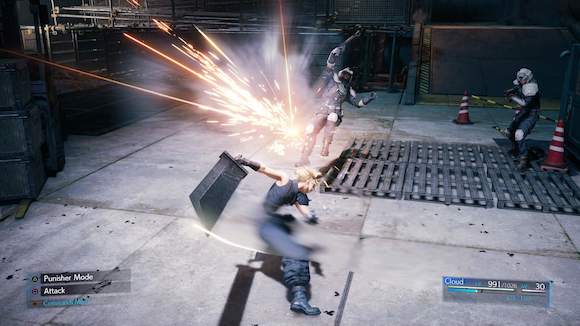
Final Fantasy VII Remake
I don’t have a particular affinity for Final Fantasy in general or Final Fantasy VII in particular. I didn’t play the original on PlayStation—I just had an SNES and would’ve been playing Super Mario RPG around that time—and even though I was an avid game magazine reader, the hype and discourse around the game didn’t grab me. I eventually played FFVII many years later on PlayStation 4. And even then, I made liberal use of the re-release’s invincibility and 3X speed options to zoom past the grindy gameplay and see the rest of the story. So, I wasn’t necessarily excited for Final Fantasy VII Remake and didn’t check it out when it released in early 2020.
But one thing I love about games is that passion can be contagious. One of my favorite gaming outlets, MinnMax, went all-out on Final Fantasy VII Remake coverage—mostly because its founder is an FFVII fanatic from way back. The centerpiece of this was MinnMax’s signature “Deepest Dive”podcasts, a multi-part, multi-hour discussion of a game from front to back. The prospect of listening to hours and hours of excited conversation about the game from knowledgeable, insightful, and funny hosts made me pull the trigger and try Final Fantasy VII Remake. I’m glad I did—the game’s combat system is chaotic but satisfying, the visuals are mostly stunning, and the changes made from the original game are smart and surprisingly thought-provoking. I’ll be there when MinnMax dives into Final Fantasy VII Rebirth, the sequel, in winter 2023.
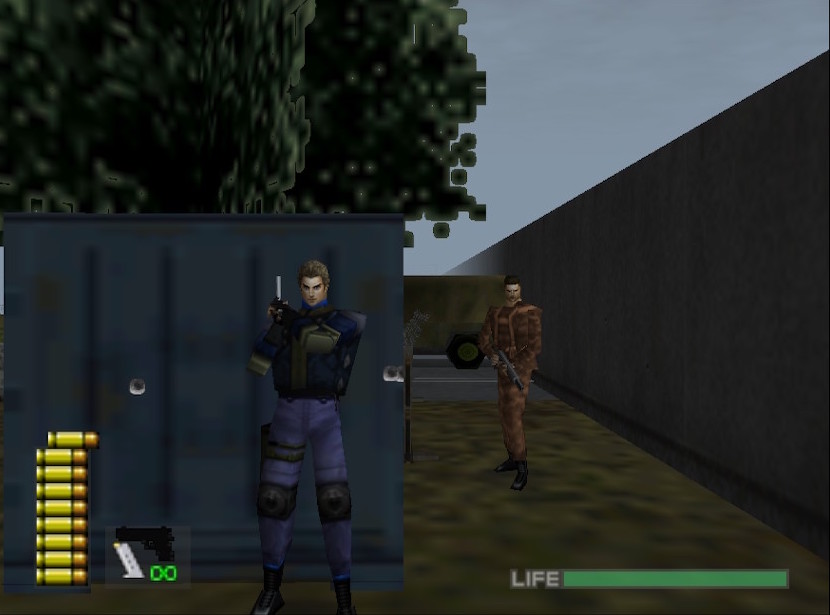
WinBack
WinBack is a third-person shooter from Japanese developer Koei Tecmo that released in 1999 for the Nintendo 64. I never played it back then; for me WinBack has always just been a punchline representing the kind of middling, forgotten game that third-party developers put out for Nintendo’s consoles in that era. (Iggy’s Reckin’ Balls, anyone?) I might have vaguely known that WinBack had some significance in pioneering cover mechanics in shooters, but that was about it.
Ladies and gentlemen of the jury, I must plead forgiveness—WinBack rules. The controls are a little clunky, sure, but once you grasp them, it becomes clear how this game inspired Resident Evil 4, Gears of War, and so many shooters that came later. Once you get into the groove of its gameplay, it’s actually thrilling to dive into cover, pop out for a few quick shots on the enemy, and hunker down again. Plus—the story, characters, and dialogue are absolutely delightful in their campiness and cheesiness. It all feels like my favorite kind of action movie; I’m so glad to have discovered WinBack this year.
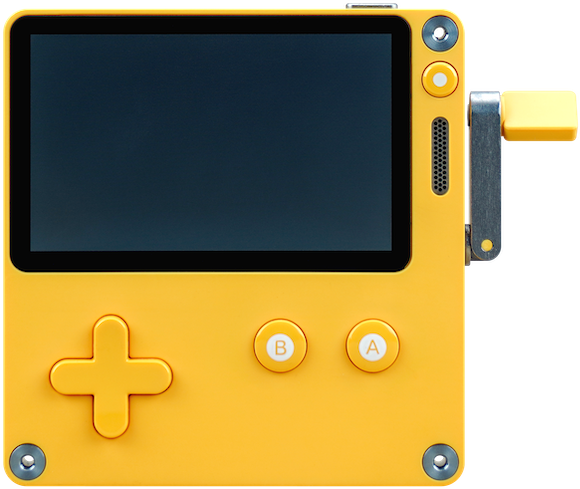
Playdate
Definitely wins this year’s Niftiest Thing award. The Playdate is a little yellow handheld that looks a bit like a squished GameBoy. It’s got a crank on the side as one of the control inputs, and it doesn’t take cartridges. A “season”of 24 games is preloaded on the unit, and you can (surprisingly easily) sideload more games onto it with the included software. In a super smart move, the 24 games you get with the Playdate aren’t all playable when you get the console—instead, they unlock weekly, two at a time. For some people this could be annoying, but I liked being able to focus on a few games, and then look forward to next week’s drop.
The hardware is extremely cute and works well, though the screen is hard to see in all but the most perfect lighting conditions. The games themselves are a mixed bag, though I appreciate that different games in the season will appeal to different people. Probably half of the 24 I tried once and then never played again;only a few stuck with me for multiple play sessions. Among these were Pick Pack Pup, a match-three puzzle game with a fun aesthetic and a great name, and Whitewater Wipeout, a top-score chasing surfing challenge that’s extremely reminiscent of California Games on the Apple II. To me Playdate is best in short bursts, which is what these two games are built for. The simplicity and pure fun of Playdate was refreshing this year, and I’m excited to see what else developers can do on it.
Hot Shots Tennis
I love a tennis video game, but the trouble with a lot of recent ones is that they’re not good. I’ve tried a few on Xbox GamePass that failed to keep my attention any longer than a service game or two. But then I found Hot Shots Tennis. This PlayStation 2 tennis game came out in 2006, and it was made available this year on the new tier of Sony’s PlayStation Plus service, the one that includes various old games. It’s super cool! It’s obviously less of a realistic simulation than many modern games try to be, but that’s fine—I like that it’s a tennis game, but it’s just as important that it actually be fun, and Hot Shots Tennis delivers. Along with Rollerdrome, which I played around the same time, it had one of the most satisfying skill curves I experienced this year. It took a while to grasp the mechanics, but once I did I could very clearly feel myself getting better and learning how to counter the computer’s moves. For me this ends up in the top pantheon of tennis games, alongside such classics as Virtua Tennis on Dreamcast and Mario Tennis on Game Boy Color.